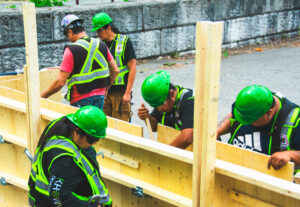
Training leading directly to careers in B.C.
By Adam Freill
Construction LabourFour-week program from Carpenters’ Regional Council lands Indigenous tradespeople real work experience on hospital replacement project.
British Columbia’s Carpenters’ Regional Council (CRC) recently held a four-week Introduction to Carpentry and Formwork program for six Indigenous tradespeople to give them a head start in the construction industry. This course was specifically offered to prepare these new tradespeople to work on the Cowichan District Hospital Replacement Project (CDHRP), where they will have the opportunity to help build the new healthcare facility that will provide expanded care to their community members. All participants were members of local First Nations, including the Cowichan Tribes.
The course covered safety-related topics such as jobsite hazard awareness, accident and injury prevention, and promoting worksite safety. Practical topics included measuring, marking and layout tools, basic carpentry hand tools, power tools for cutting, shaping, fastening and finishing, as well as drawing interpretation and some trades math.
Weeks three and four of the course were dedicated to hands-on projects involving wood framing and concrete formwork. Course instructor, CRC trainer Tim Bolderson, shared his enthusiasm about the long-term impact of courses like these.
“These introductory courses are often the first of many training courses our members take, so they tend to stick with people as they pursue their careers,” he explained. “Participants have later told me that it’s during these introductory courses that they decided that this is what they want to do for a living.”
The six course participants began work at the CDHRP in July, just days after graduating. With such high demand for skilled tradespeople in British Columbia, newly trained individuals can often expect to be out working in the field as soon as they complete their introductory training, said Bolderson, adding that he is confident that the individuals have all the tools they need to be successful on major projects like the CDHRP.
“They’re ready to go. Everyone starts somewhere. This just happens to be a large-scale project. But the fundamentals are the same,” he said.
The new hospital will be three times larger than the current facility, with a capacity for 204 beds. It will also be the first fully electric hospital in B.C. The carpentry course was a joint effort by the Carpenters’ Regional Council, the Nutsa’Maat Alliance (Island Health, EllisDon, Parkin Architects, Infrastructure BC, and the skilled trades employer, BC Infrastructure Benefits), and Khowutzun Development Corp.
The construction of the estimated $1.45-billion, 607,601 square-foot hospital is expected to be completed in 2026 and ready for patient care in 2027.





